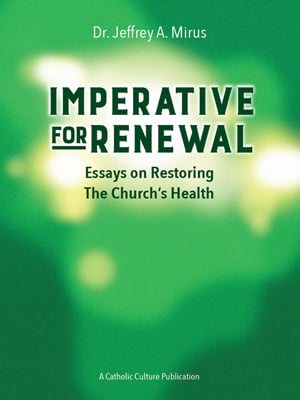Family-based catechesis for home and parish: A breakthrough
By Dr. Jeff Mirus ( bio - articles - email ) | Mar 23, 2017 | In Reviews
Sophia Institute has recently published the materials for the first year of a new four-year religious education program which is firmly rooted in family life. This is an important development in catechesis. As one parent put it, “I’m so happy that we’re now treating our Faith as a central part of our family life and not as something we just drop the kids off to do once a week.” The new program follows an approach that is actually quite similar to what Jennifer Gregory Miller and Darden Brock have tried to build into our Liturgical Year materials on CatholicCulture.org, except that it is focused on a structured program of catechesis rather than (as we put it) “living the liturgical year in the domestic church.”
The Sophia Institute program is called A Family of Faith and it will ultimately consist of materials for a four-year program which explores the four equivalent sections of the Catechism of the Catholic Church. In other words:
- Year One: The Creed
- Year Two: The Sacraments
- Year Three: Life in Christ
- Year Four: Christian Prayer
Each year’s materials consist of a Parent’s Guide, an Activity Book for the children, and (when the program is used in a parish context) a Leader’s Guide. The easiest way to see how the program works is to explore the presentation on the Sophia Institute website. But to put the matter briefly:
- The parent materials for each lesson provide a brief exposition for the parents and tell which Catechism sections they should read. They list the Catholic vocabulary which is incorporated into each lesson and then offer the following: an opening prayer, questions to explore, Scripture memorization, creative projects, approaches to discussion, and the additional direct instruction the parent will want to provide to older children. The Parent’s Guide also includes full-color reproductions of a number of famous Catholic works of art relating to the themes covered, along with discussion points.
- The children’s activity books enable children to learn the vocabulary and prayers most associated with each lesson while offering a number of activitie as well, such as Scripture searches, word searches, creative projects (writing, coloring, drawing, composing), examination of famous Catholic paintings, saint stories, guided scriptural analysis, timelines, related family games and activities, and so on.
- The leader’s guides (which I have not seen) are designed for use in a parish where a number of families will follow the program. In this case, the parents would gather once a month to be catechized by the leader(s) through presentations and discussions (Sophia Institute provides all necessary lecture notes, activities and handouts). Two weeks later the families would gather after Sunday Mass for a short meeting and activities “from picnics and feast day celebrations to prayer groups and adoration.” Meanwhile, over the course of the month, parents would typically teach their children two lessons at home.
Note that a different saint is highlighted each month. Learning about the saint is a thread which runs through the lessons and activities of that month. In children, the saints nearly always occasion special interest.
Key points
It is very important that A Family of Faith is not only rooted in the family but closely linked to Scripture. This Scriptural focus mirrors the Catechism. Moreover, as with the sacraments, it provides the Holy Spirit with preeminent opportunities to move not only the mind but the heart. This is so important that the very first thing the program asks of parents, before beginning any lesson, is to take the time to gain a basic familiarity with the Bible, how it is organized, and what can be expected to be found in its various parts.
A very minor confusion for me as a reviewer was the statement in the advertising flyer that the program covers one section of the Catechism each year from September through May. In the initial year, September is devoted to preparatory work to get parents and children up to speed with a “family storybook”, a basic orientation to Scripture, and some basic prayers. But the last month for which lessons are offered is April. One could, of course, make more extensive use of the beautiful appendix of sacred art resources in May.
While thinking about this, I noticed that there are thirteen lessons covering October through April and that each month has two lessons except December, which has only one (wisely, in my view, because of the attention that should be paid to Christmas). It occurred to me that any two of the other three special liturgical seasons (Advent, Lent and Easter) could fairly easily give up a lesson as well, especially if the family were spending a bit of time following our own recommendations for involvement in each liturgical season (recommendations which appear day by day in our liturgical calendar, as well is in the “workshops” we provide for each liturgical season). Proceeding in this way, there would be two lessons left to teach in May, or perhaps even two for May and one for June.
That would be one way to avoid the possibility of ignoring religious instruction altogether for too many months, and it better matches the experience most families have with formal education. Note that, as family-oriented as this new program is, it would be a mistake not to pursue it in some sense formally, for the simple reason that it would never get done. At the same time, those who put all this together are well-aware that religious education is best adapted to the particular needs, opportunities, strengths and weaknesses of each family and, indeed, each child. To close the loop on this, I should say that the entire series is based on a program conceived by Mary Mosher, founder of Holy Family Academy in Manchester, NH and mother of five adult children who, thankfully, remain active Catholics. She is also one of the five writers who drafted the materials. I should also add that extensive additional resources for both older and younger children are available at SophiaInstituteforTeachers.org.
In any case, I am deeply impressed with what Sophia Institute has accomplished in preparing and publishing A Family of Faith. I would add only the importance, for all the families who use the program, of living in a very clearly counter-cultural way, so that their children can gain courage and confidence in their marked differences from so many others. Without this deliberate counter-cultural element, whatever is good in the patterns of family life is too easily lost when children venture out into the larger world. It should also go without saying that this program is not a substitute for ensuring that your children receive a thorough and formal authentically Catholic education across the board. This must not be left to those with no faith, or those who are weak in faith. Following this program may be the first step in this sort of progress, but it cannot be the last.
Perhaps the larger point is now clear enough. A Family of Faith ties in closely with a growing trend which is absolutely necessary for the Church. I mean the formation of strong and even heroic Catholic families who are capable of re-evangelizing not only the world but the members—yes, and even the leaders—of the Church herself.
All comments are moderated. To lighten our editing burden, only current donors are allowed to Sound Off. If you are a current donor, log in to see the comment form; otherwise please support our work, and Sound Off!








